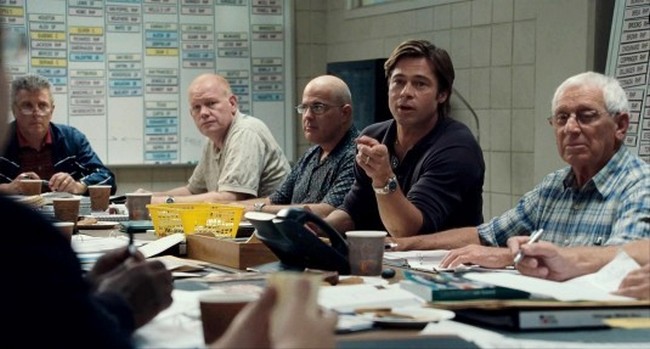During this week I’ve been sitting at my desk thinking what would be the topic for the next article to post on the Yu-Track blog, asking myself: How do I get my neurons to start working to their full power? How do I get the reader’s attention again? How can I bring out that literary artist in me? (or at least that’s what I want to believe). Suddenly, I’ve got an excellent idea, I immediately took the mobile and ordered some pizza to get my creativity back. Yes sir!
Well, after eating several pieces of pizza I realized something important, my neurons were still somewhat off. The pizza didn’t work at all. I remembered a movie recommendation by a college. She told me she quite liked it, it’s called »Moneyball», a film released in 2011 directed by Bennet Miller and starring actors Brad Pitt and Johan Hill.
The movie Moneyball is based on a true story and is about Billy Beane (Brad Pitt), a former baseball player and who’s currently general manager of the Oakland Athletics. This film was set in 2001 and things weren’t doing well at all for the team.
We have Mr. Beane, an ex-baseball player who had an unmemorable career in his youth, and the Oakland Athletics, who back then played worse than my grandmother -when she has just woken up and without glasses on-. This was a chaotic situation for the team, since we’re not only talking about poorly coordinated players who did nothing but lose game after game, but they also lost three highly important members of the team: Johnny Damon, Jason Giambi, and Jason Isringhau.
On top of that, there was another issue at that time with the Oakland Athletics, their very low budget, which was much lower than those of major league teams that year. All of this gives a much more pessimistic air to the plot.
The Oakland Athletics living in a world without KBIs
In the year 2001, time in which the movie «Moneyball» takes place, the great baseball teams were not guided by statistics when deciding which player to sign. The talent scouts relied entirely on their judgment when selecting the next superstar. They followed their instinct, their hunch.
Since they didn’t rely on statistics when scouting new talent or trading players, many would-be prospects went unnoticed by big managers in this multi-million-dollar business, as many athletes had a mix of skills that simply went undetected. Once analysed through detailed statistics, their talent was more than evident. This is the premise of the movie »Moneyball»: to make use of statistics, to know the strengths and weaknesses of the members of our team to get the best out of them and subsequently make them move towards a common goal. In this way, we can face the challenges that life offers us, face those complicated situations in which we believe that we won’t be able to emerge victorious
The main plot of »Moneyball” is the wit used by Mr. Billy Beane and Mr. Peter Brand, which we will talk about next. Once I was moving forward in the plot of the movie, I noticed something very curious. Billy Beane and his partner Peter Brand (Johan Hill) were implementing a system made up of KBIs to outweigh the loss of those three-star players. They signed new baseball players to fill those gaps! They measured the capabilities of all those baseball players available to hire, looking for those “hidden gems», those »ugly ducklings» nobody wanted. These players could be of some use for the Oakland Athletics and their difficult situation.
The Oakland Athletics hit the jackpot thanks to KBIs
This last part of the article contains spoilers.
SPOILER ALERT.
Having said that, we continue. Thanks to KBIS, the Oakland Athletics gradually got better and found themselves climbing higher positions within the team ranking for the championship games, although of course, this wasn’t easy at all. The strategy implemented by Billy Beane and his friend Peter Brand (brain behind all that statistical analysis) was initially rejected by many colleagues. It was a tortuous path to success, in which they received great pressure for part of the general public because of singing players who were not well seen by the majority.
But why signing players already labelled as ‘lame’ who were only worth a few thousand dollars over more promising ones who were worth millions of dollars? Well, you yourself have read it. These baseball players were extremely cheap to sign, something that was necessary due to the limited budget the Oakland Athletics had. Although the reasons for hiring these »ugly ducklings» was not only the low cost of their hiring… Anyhow, thanks to the implementation of a good KBI system, patterns could be discovered. The style of play these baseball players had been practically gold and this wasn’t perceived by others. Our main characters took advantage of that immediately.
What was the technique used by Billy Beane and Peter Brand to fill the void left by Johnny Damon, Jason Giambi, and Jason Isringhausen on the Oakland Athletics? Take those baseball players who, despite of not being good at everything, did have certain skills on the field that were really exceptional and that could lead them to victory just by making a few small adjustments into their style. These two individuals did something incredible and never seen before in the history of the MLB. They did a deep KBI analysis of a large number of athletes, detecting their weaknesses and strengths in order to achieve a well-rounded team. They won 20 games in a row, a milestone in the history of the Oakland Athletics.
The Oakland Athletics and their success
The success of this team could only have been achieved by employing the KBIs to gain a broader understanding of the players; using the information gained from these statistical analyses to leverage and deploy game strategies that no major baseball team had used at the time.
The strategy implemented by the Oakland Athletics using KBIs to rebuild their baseball roster was unprecedented in baseball history. For the first time, the industry giants began to look more at the «whys» and less at the amount of home runs a certain player achieves. The implementation of KBIs was so successful that shortly after, the Boston Red Sox won their first World Series in 2004. They hadn’t achieved such a triumph since 1918 and yes… all thanks to the use of KBIs.
As always, it’s a huge honour to share these curious facts with you. If you haven’t watched “Moneyball” yet, then I recommend you to watch it ASAP. It’s a film with a significant life message. Until next time!














